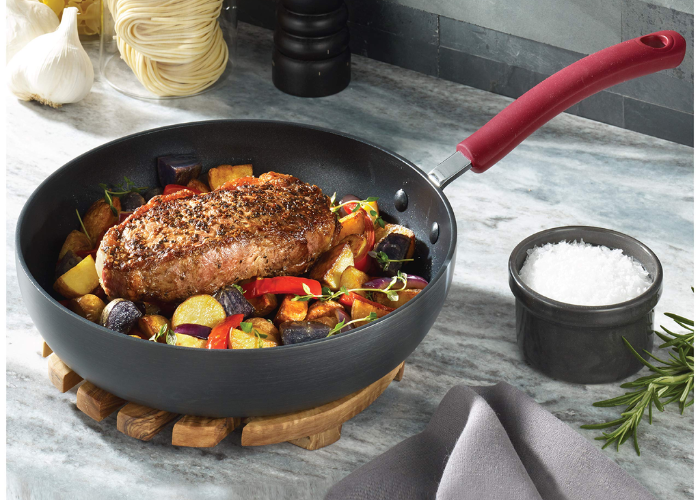Have you ever wondered why a certain dish doesn’t come out the way you expect it to, even though you follow the recipe to the letter? Could it be that the problem lies not with your cooking skills but with your skillet?
Every cooking enthusiast understands that the tools you use in your kitchen can be just as important as the ingredients you choose. And when it comes to skillets, understanding the different types of materials and how they impact your cooking is essential.
This article will dive into various frying pan materials, explore their properties, pros, and cons, and help you identify the right skillet material for your cooking style.
Cast Iron Skillets
Characteristics and Benefits
A stalwart in the world of cookware, cast iron skillets have earned their place in kitchens worldwide due to their exceptional durability and heat retention properties. These heavyweight champions are perfect for high-temperature cooking methods such as searing and baking.
One of the most significant benefits of cast iron is its ability to provide even heat distribution. This feature is especially useful when cooking foods that require a steady heat level, like pancakes or cornbread. Moreover, a well-seasoned cast iron skillet has a naturally non-stick surface.
Drawbacks
Despite their numerous benefits, cast iron skillets aren’t without their drawbacks. They can be heavy and require regular seasoning to maintain their non-stick properties. Additionally, they are unsuitable for acidic foods, as the acid can react with the iron and give your food an off-flavour.
Best For
Cast iron skillets are best for slow-cooking dishes and foods that need an evenly heated surface. They’re also excellent for oven-to-table presentations, thanks to their rustic charm.
Stainless Steel Skillets
Characteristics and Benefits
Renowned for their sleek, shiny look, stainless steel skillets are aesthetically pleasing and incredibly durable and resistant to rust or staining. They can handle high heat, making them perfect for searing and browning.
One of the main benefits of stainless steel skillets is that they are non-reactive, meaning you can cook any food, including acidic and alkaline substances, without worrying about any chemical reactions that could alter the flavour of your food.
Drawbacks
However, they aren’t naturally non-stick, so you may need more oil or butter when cooking certain dishes. Moreover, they do not distribute heat as evenly as other materials, potentially leading to hot spots.
Best For
Stainless steel skillets are versatile and are best for sautéing, searing, and making pan sauces. They’re also an excellent choice for beginners due to their forgiving nature.
Non-Stick Skillets
Characteristics and Benefits
Non-stick skillets are a popular choice for many due to their convenience. As the name suggests, these skillets have a non-stick coating (usually made from Teflon) that allows food to slide off easily, making them ideal for cooking delicate foods like eggs or fish.
In addition to their non-stick feature, they require less oil or butter, making them a healthy option for those looking to cut down on fats. They’re also easy to clean, a big plus for those with busy schedules.
Drawbacks
However, the non-stick coating on these skillets can degrade over time, especially when used over high heat or cleaned with harsh scrubbers. Also, once the coating starts to chip, the pan should be replaced to avoid consuming the non-stick material.
Best For
Non-stick skillets are ideal for cooking delicate foods and dishes that stick easily, like pancakes, eggs, and fish. They are also excellent for those learning to cook due to their forgiving nature.
Copper Skillets
Characteristics and Benefits
Beloved by professional chefs for their quick heating and cooling properties, copper skillets are a luxury in the kitchen. Their superior thermal conductivity allows them to heat up and cool down faster than any other material, providing precise control over your cooking.
Drawbacks
On the downside, copper skillets are expensive and require a lining of stainless steel or tin because copper can react with certain foods. They also require regular polishing to maintain their shiny appearance and can dent easily.
Best For
Copper skillets are best for precise cooking tasks where rapid temperature changes are needed. They are perfect for high-end kitchens and those who value aesthetics and functionality.
Conclusion
Choosing the right skillet material is crucial to mastering your culinary skills. The choice largely depends on your cooking style, what you typically cook, and your lifestyle needs. Whether you opt for the classic cast iron, versatile stainless steel, convenient non-stick, or luxurious copper, remember the right skillet can elevate your cooking experience to new heights. So choose wisely and let your skillet be the secret ingredient to your delightful culinary creations.
Remember, no single skillet can do it all. Most chefs and home cooks have a variety of skillets in their kitchen, each serving a different purpose. Investing in good-quality skillets can provide a versatile toolkit for creating various dishes.







